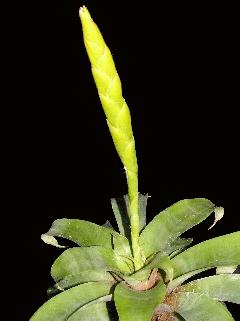


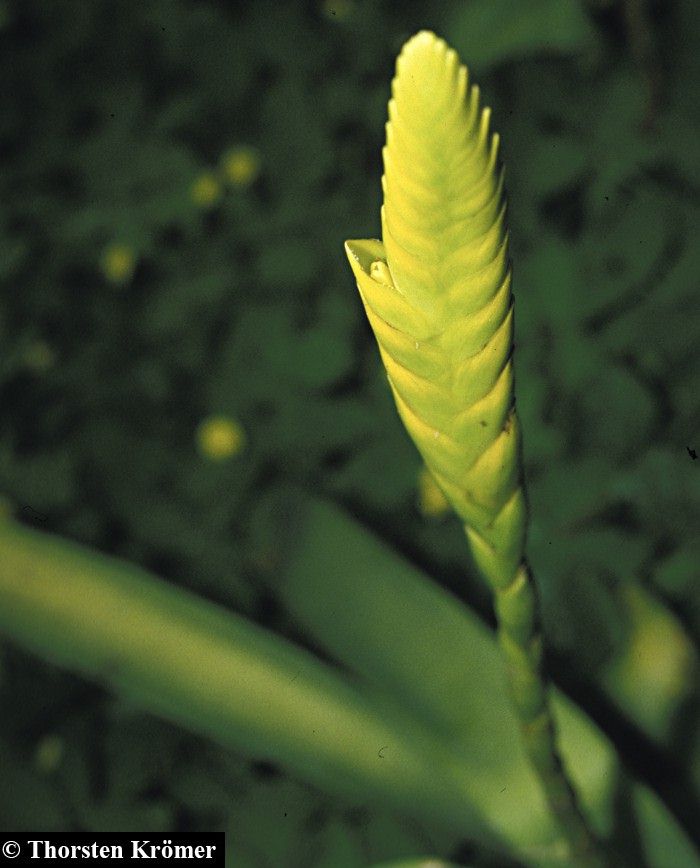

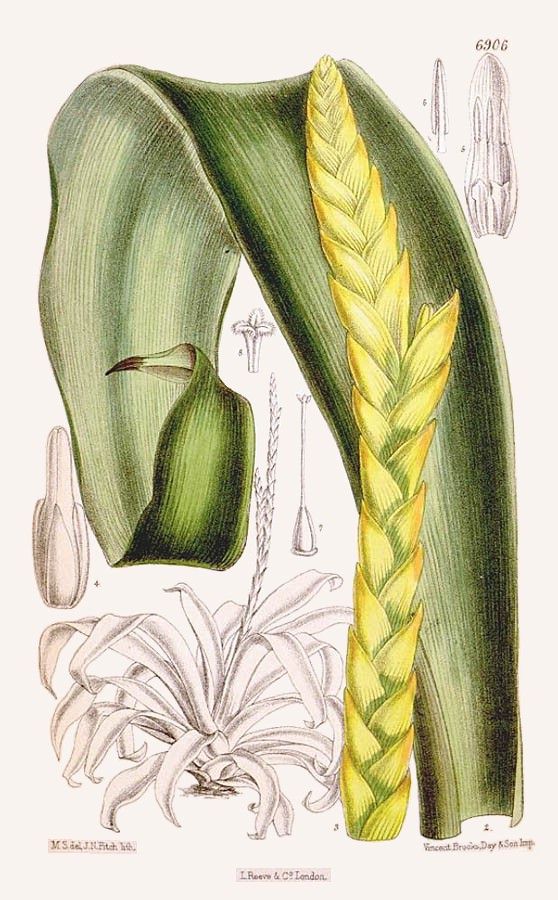
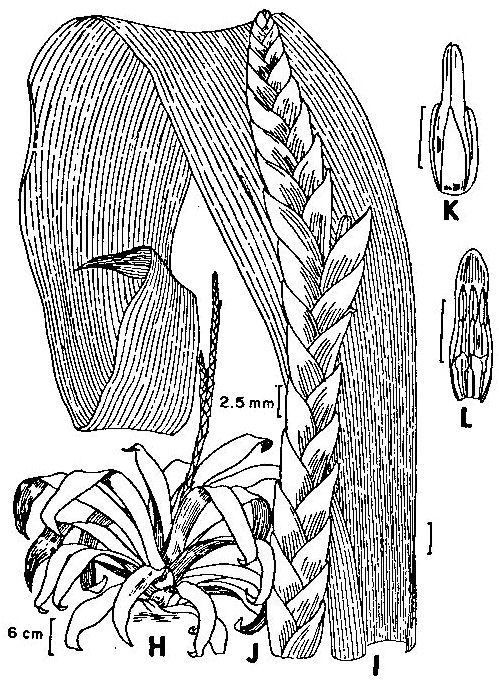
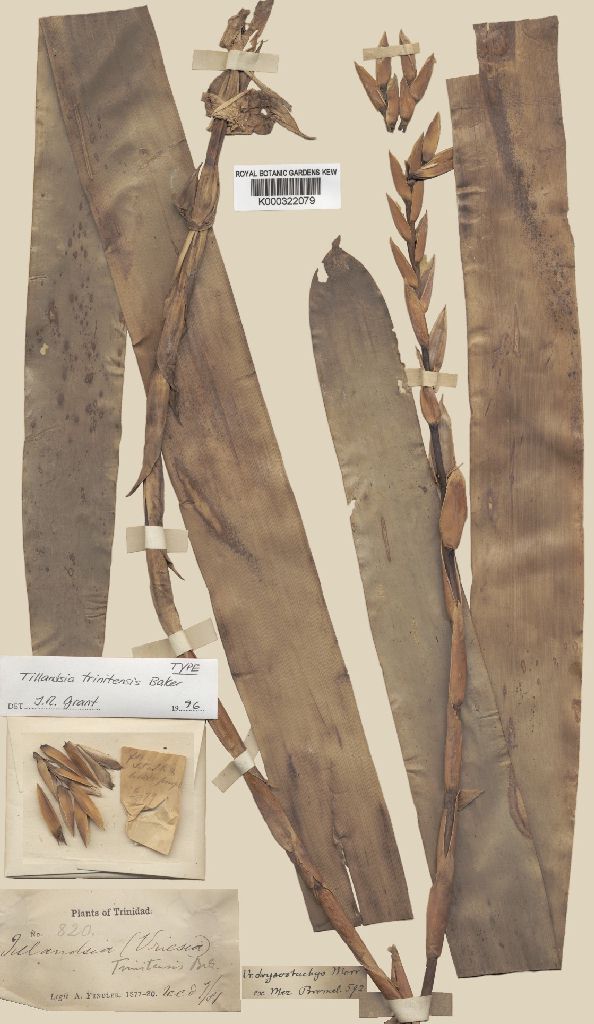
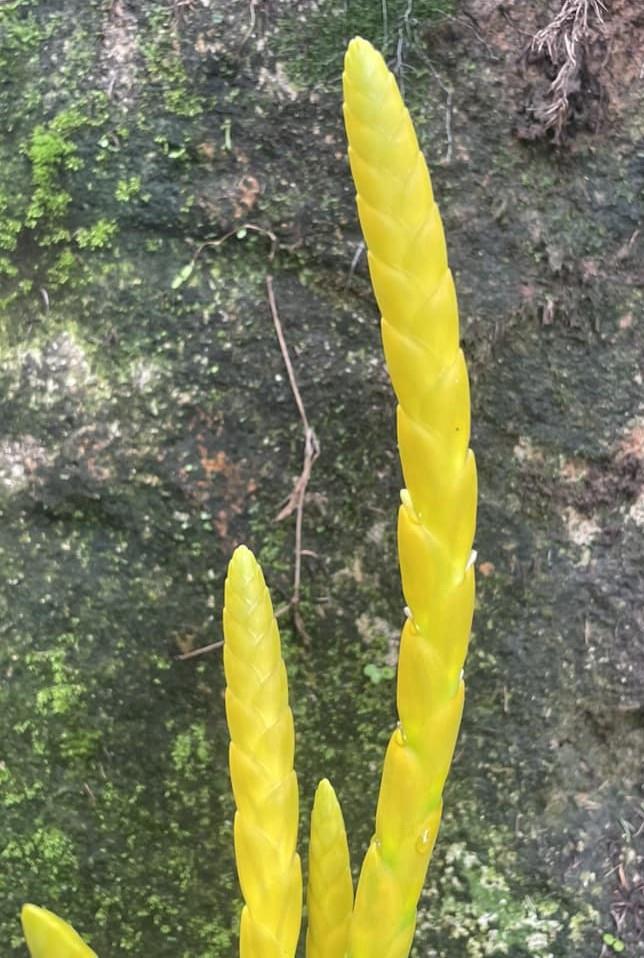
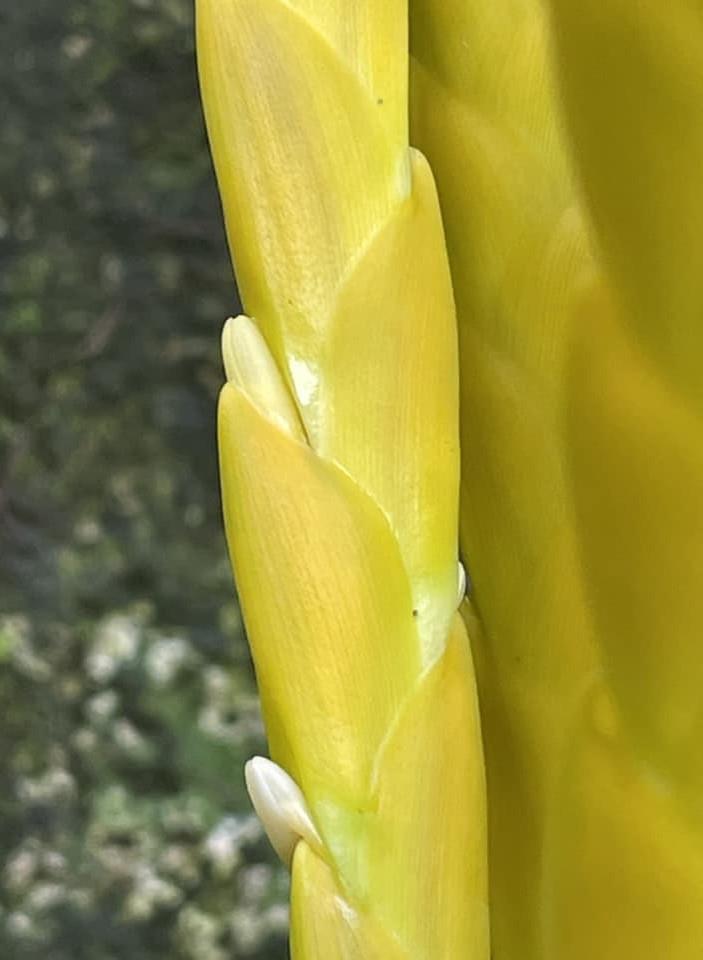
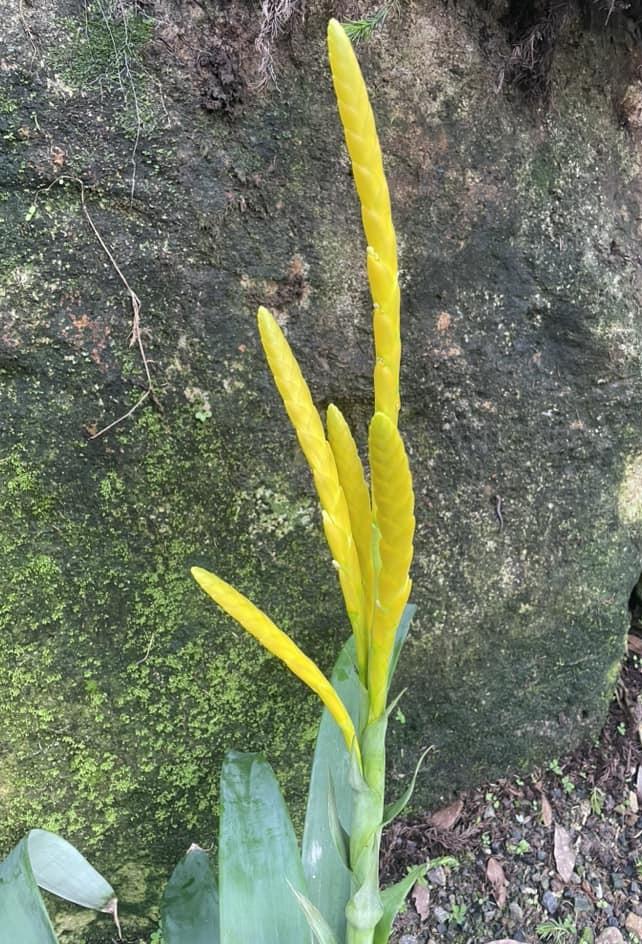
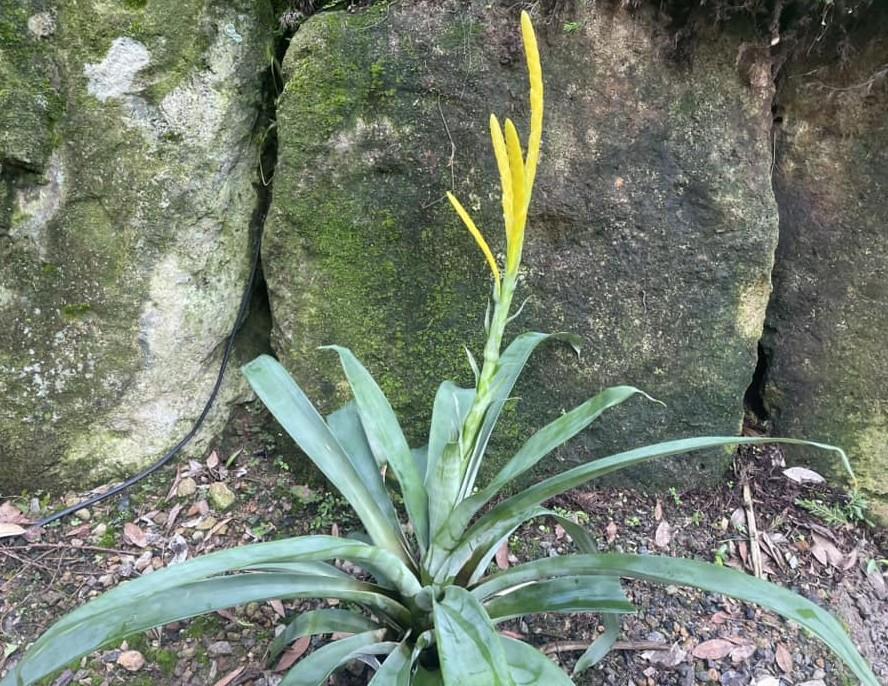
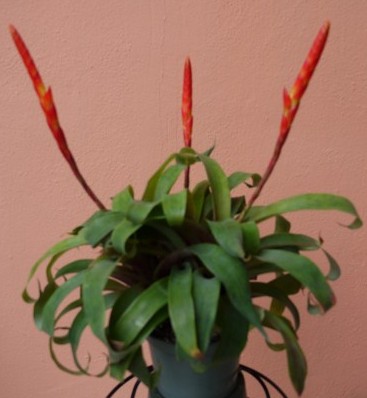

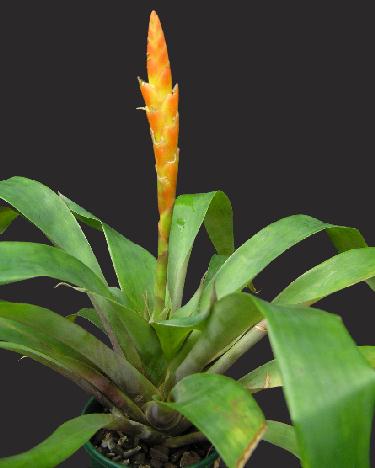
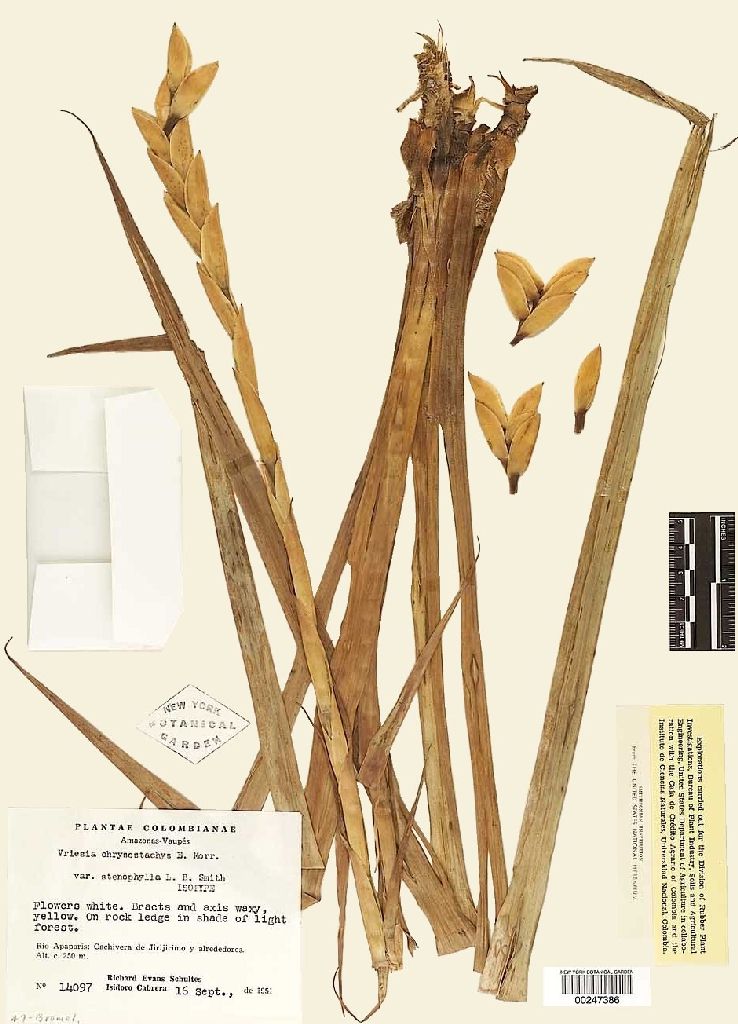
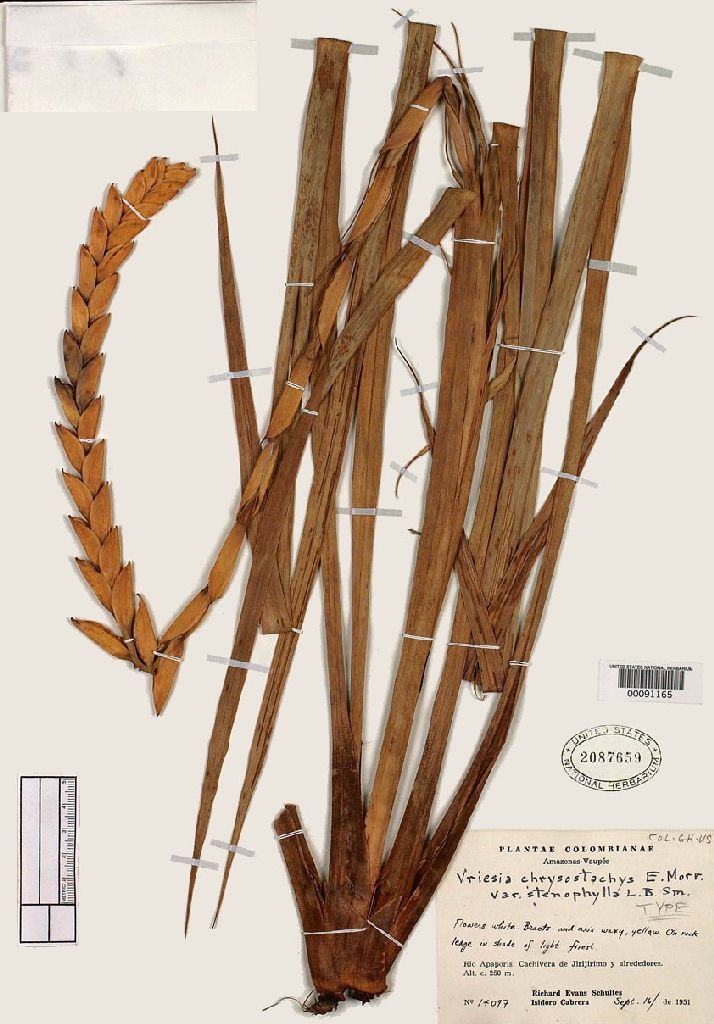
Goudaea chrysostachys (E. Morren) W. Till & Barfuss, comb. nov. Phytotaxa 279(1): 001-097. 2016
Basionym:—Vriesea chrysostachys E. Morren, Belgique Hort. 31: 87 (1881), Type:—Davis s.n. in Veitch Hortus s.n. (holo ?LG)
= Tillandsia chrysostachys (E. Morren) Baker, Bot. Mag. 112: pl. 6906 (1886)
= Tillandsia trinitensis Baker, Handb. Bromel.: 211 (17 Aug–15 Oct 1889), Type:—Fendler 820 (holo K!)
Vriesea chrysostachys E. Morren, Belg. Hortic. 31: 87. 1881.
Desc from S&D
Plant stemless.
Leaves 3-5 dm long;
Sheaths elliptic, densely ferruginous-lepidote;
Blades linear to lanceolate, minutely punctulate-lepidote.
Scape slender, erect; scape bracts imbricate, broadly ovate, the lower acuminate, the upper obtuse.
Inflorescence of 1-4 spikes;
Primary bracts short and inconspicuous;
Spikes linear, 1-6 dm long, complanate, many-flowered.
Floral bracts densely imbricate, broadly ovate, triangular-acute, 25-35 mm long, exceeding the flowers, ecarinate, yellow, coriaceous;
Flowers subsessile, 25 mm long.
Sepals lance-ovate, 15 mm long;
Stamens included.
Vriesea chrysostachys var chrysostachys
Tillandsia chrysostachys (E. Morren) Baker, Bot. Mag. 112: pl. 6906. 1886.
Tillandsia trinitenis Baker, Handb. Bromel. 211. 1889. Type. Without locality, Trinidad, Fendler 820 (K, GH photo), 1877-80.
Tillandsia aurea hortus ex Baker, Handb. Bromel. 222. 1889; nomen in synon.
Tillandsia cryptantha hortus ex Baker, Handb. Bromel. 222. 1889; nomen in synon. Based on Morren Icon (K).
Leaf-blades rounded and apiculate to acuminate, 4-5 cm wide.
Inflorescence simple or rarely compound.
Petals yellow.
Type. Davis in Hort. Veitch s n (LG n v), without locality, Peru, 1875, cultivated to flower 1881. Later collection, (LG, GH photo), Jul 1884, evidently from same stock. DISTRIBUTION. Terrestrial and saxicolous, savanna and woods, Trinidad, eastern Colombia and Peru.
COLOMBIA. META: Rio Sansa, Cordillera La Macarena, 23 Jan 1951, Idrobo & Schultes 1309 (COL, US); northern Sierra de la Macarena, 15 Mar 1956, Vogel 304 (US). VAUPES: Cano Pacu, Rio Vaupes, Circasia, 6 Mar 1944, Schultes 5826 (GH); Cerro Isibukuri, Rio Kananari, 4 Aug 1951, Schultes & Cabrera 13386 (COL, GH, US, dwarf); same, 0°15' N, 70°35' W, Jan 1952, Schultes & Cabrera 15083 (COL, US); Rio Piraparana, 0°15' S - 0°25' N, 70°30' W, 18 Sep 1952, Schultes & Cabrera 17512 (COL, GH, US); Mesa de Yambi, Rio Karurtu, 1°20' N, 71°20' W, Apr 1953, Schultes & Cabrera 19118 (COL, GH, US); Cerro de Tipieca, Rio Vaupes, Mitu to Javarete, May 1953, Schultes & Cabrera 19309 (COL, GH, US); Teresita, Rio Papuri, 28 May 1953, Schultes & Cabrera 19486 (US); Raudal de Yurupari, Rio Vaupes, 0°40' N, 70°30' W, Nov 1951, Schultes & Cabrera 19714 (COL, US). CAQUETA: Florencia, Cerro de la Sargentia, 30 Mar 1940, Cuatrecasas 8912 (COL); Venecia, Florencia, 22 Apr 1956, Vogel 26 (US). AMAZONAS-VAUPES: Cachivera de Jirijirimo, Rio Apaporis, 11 Jun 1951, Schultes & Cabrera 12366 (COL, GH, US); Mar 1951, Schultes 12087 (COL, US). PERU. JUNIN: La Merced, Jun 1929, Killip & Smith 24010 (US).
Goudaea chrysostachys var. stenophylla (L.B. Sm.) W. Till & Barfuss, comb. nov. Phytotaxa 279(1): 001-097. 2016
Basionym:—Vriesea chrysostachys var. stenophylla L.B. Sm., Bot. Mus. Leafl. 17: 71 (1955),
Type:—Schultes & Cabrera 14097 (holo US!; iso COL!, GH, K!, NY!); Schultes & Cabrera 14596 (para COL, GH, US); Schultes & Cabrera 14936 (para COL, GH, US)
Vriesea chrysostachys var stenophylla L. B. Smith, Bot. Mus. Leafl. 17: 71. 1955.
Desc in S&D
Leaf-blades acuminate, ca 1 cm wide.
Inflorescence simple.
Petals white.
Type. Schultes & Cabrera 14097 (holotype US, isotypes COL, GH), Cachivera de Jirijirimo, Rio Apaporis, Amazonas-Vaupes, Colombia, 16 Sep 1951.
DISTRIBUTION. Saxicolous in forest, 250-270 m alt, southeastern Colombia.
COLOMBIA. AMAZONAS-VAUPES: Raudal de Jirijirimo, Rio Apaporis, 0°5' N, 70°40' W, 25 Nov 1951, Schultes & Cabrera 14596 (COL, GH, US); 21 Jan 1952, 14936 (COL, GH, US).
Pers Comm H Luther Feb 2012 The smaller plants from Ecuador to Bolivia I call Vriesea chrysostachys var. stenophylla. Bracts can be yellow, orange or red; corolla creamy white to pale yellow. Probably not a strong variety, another case of little'uns and big’uns across a big range of territory.
Protologue
Tillandsia trinitenis Baker, Handb. Bromel. 211. 1889. Type. Without locality, Trinidad, Fendler 820 (K, GH photo), 1877-80.
237. T. TRINITENSIS Baker.-
Leaves thin, flexible, subglabrous, lorate, obtuse, 2˝ ft. long, 1˝-2 in. broad at the middle. Peduncle 2 - 3 ft. long; bract-leaves many, all small, adpressed, scariose. Inflorescence a simple moderately dense spike 6-8 in. long, with all the flowers ascending ; flower-bracts ovate, acute, reddish, nearly an inch long. Calyx not longer than the bract. Petals not seen.
Hab. Trinidad, Fendler 820 !
TAB. 6906.
TILLANDSIA CHRYSOSTACHYS.
Native of Peru.
Nat. Ord. BROMELIACEAE.-Tribe TILLANDSIEAE.
Genus TILLANDSIA, Linn. (Benth. et Hook. f. Gen. Pl. vol. iii. p. 669.)
TILLANDSIA (Vriesea) chrysostachys; acaulis, foliis 20-30 dense rosulatis lanceo¬latis falcatis viridibus haud lepidotis dorso deorsum brunneo tinctis, pedunculo elongato foliis pluribus reductis rigidulis imbricatis tecto, spicis distichis elongatis simplicibus vel furcatis, bracteis ovatis navicularibus imbricatis citrinis, floribus bracteis aequilongis, sepalis liberis lanceolatis, petalis liguIatis obtusis luteis basi appendiculatis, staminibus petalis brevioribus, stylo elongato, stigrnatibus brevibus patulis.
Vriesea chrysostachys, E. Morren in Belg. Hort. vol. xxxi. (1881), p. 87.
This beautiful new species of Vriesea was introduced into cultivation by Messrs. Veitch in the year 1881. They received it from their collector, Mr. Davis, who discovered it in the forests of the Peruvian Andes. It was described at the time by the late lamented Professor Edward Morren, but has never been figured.
The striking point about it is the long yellow spike, in allusion to which the specific name was given, and which remains in good condition for a long time, as the coloration resides mainly in the coriaceous bracts.
Our drawing was made from a plant that flowered at Kew in May, 1886.
DESCR. Acaulescent. Leaves about thirty, arranged in a dense rosette, lanceolate, thin in texture for the Order, entire, a foot or a foot and a half long, two or two and a half inches broad at the middle, bright green on the face, without any bands or spots, paler green on the back, tinged towards the base with claret-brown. Peduncle stiffly erect, about a foot long, hidden by the sheathing imbricated ovate adpressed bract-leaves. Spikes one or two, distichous, half a foot or a foot long ; bracts ovate, navicular, an inch long, imbricated, bright lemon-yellow. Flowers not protruded beyond the bracts. Sepals free, lanceolate, half an inch long. Petals ligulate, obtuse, bright yellow, an inch long, each appendiculate with a quadrate membranous scale above the base. Stamens shorter than the petals. Pistil nearly as long as the corolla; style, slender, elongated; stigmas short, spreading. - J. G. Baker.
Fig. 1, Whole plant, much reduced; 2, leaf; 3, spike, both life-size; 4, a complete flower; 5, a petal and three stamens; 6, a single anther; 7, complete pistil; 8, stigmas :-all more or less enlarged.